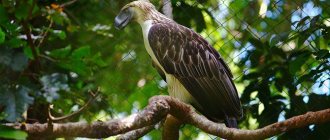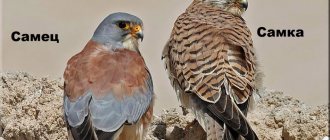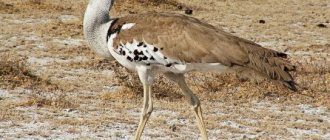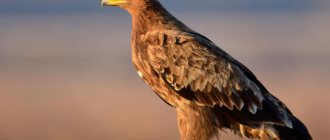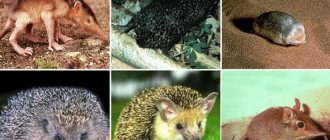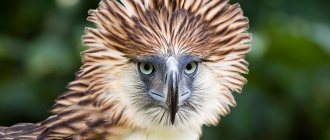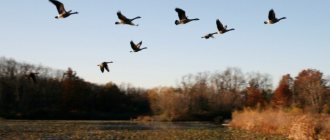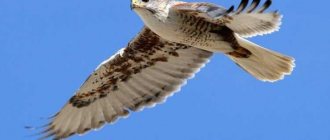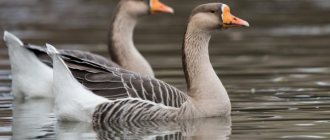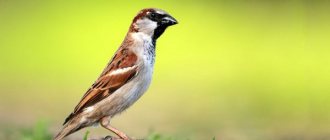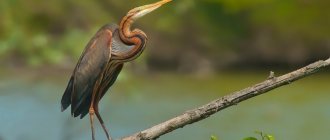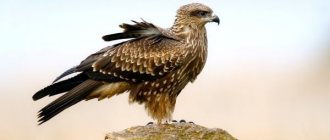Without birds, the world would not be so bright and original. There are a huge number of birds living on our planet, and as many as they are, they are also diverse. And the way they sing – the vibrant bird trills can be the envy of any singer! How often, sitting on the open veranda in the summer, we listened with pleasure to the sounds of a summer night filled with bird voices. And for some reason, it is at night that bird voices especially touch the heart. And it happens that the nightingale’s trill is replaced by the alarming hoot of an owl or the terrifying cry of an owl - the soul “goes to the ground” from such sounds.
Some lyrics
“What are you singing about, night bird?” - this expression became popular thanks to the song of Konstantin Nikolsky. People often turn to the theme of birds in their creativity. Well, their wings, the feeling of freedom of flight, nobility and beauty haunt me! These wonderful creatures attract people so much!
Among poets and writers one can often find: “hands like wings”, “like a bird in a cage”, “why don’t people fly?” and other expressions.
Ornithologists specifically study the life of birds. Feathered friends, based on their visual perception, are divided into two main types: daytime and nocturnal birds. This division is quite arbitrary. There are actually not that many nocturnal birds of prey.
Barn owl / Tyto alba
The beautiful nocturnal bird has chosen all continents of the planet as its habitat, except for ice-covered Antarctica. In the vastness of Russia, they can only be found within the Kaliningrad region.
The barn owl has a characteristic heart-shaped muzzle, as well as original plumage. Keen hearing and excellent vision make barn owls versatile night hunters. They not only see their prey in the darkness of the night, but also perfectly hear any rustle.
During the day, barn owls hide in quiet places, sleep and accumulate energy to go hunting at night. In captivity, birds display a funny sociability, making grimaces and tilting their heads.
Owl
The owl is a night bird (who doesn’t know about this). After it we can name the little-known nightjar, the nightjar; also, few people have seen the night heron and the nightjar.
Their vision is structured in a special way. Nocturnal birds see well in the dark; the following is noted in the structure of their eyes: tubular structure, a small number of color receptors. In addition, they have a very strong ciliary muscle, the task of which is to instantly change the lens from a round shape to a thin slit.
Even nocturnal birds, in addition to the two usual eyelids, have an additional eyelid, or rather a membrane, on their eyes. All these natural adaptations help the bird hunt at night and protect its eyes from unexpected changes in lighting. The beak of birds of prey is strong, hard, often curved at the end. The legs have sharp claws of quite large size.
Let's look at how night birds hunt using the example of owls. These are typical nocturnal birds. They do it in a very unique way. The owl has a kind of facial plate, with frontally located eyes. This plate is a kind of screen or radar for more accurately capturing sounds. The owl cannot look to the sides and turns its entire head, creating a location for the sound.
The wingspan is large, the body is dense and strong. An owl, having heard the slightest squeak made by a rodent, seems to strain this very facial disc and determine the direction to its prey with great accuracy. Then he rushes in the right direction. Thanks to its very soft plumage, the predator flies barely audible, and in flight it can pause for a fraction of a moment, clarifying its trajectory.
Having overtaken the victim, the owl grabs it with its paws, slightly tilting its body back. Owls feed mainly on rodents. But some large species can “feast” on a hare, duck or crow. There are several species of owls found in nature, here is a short list of them:
- long-eared owl;
- owl;
- owl;
- scoop and others.
There are approximately 140 species of these birds. Owls range in weight from 0.5 kg to 4.5 kg or more. They are found in different parts of the planet. The long-eared owl can be found in Eurasia (forest zone), as well as in North America.
Owls live in trees, in nests left by other birds. The polar owl (or white owl) lives on the coast and islands of the Arctic Ocean. Very large body (up to 160 cm), feeds mainly on lemmings.
Gray owl
This bird is part of the owl genus. And it should be noted that this species is very numerous: the spotted owl, the gray owl, the long-tailed owl and others. This type of owl is the most common in our country. If you ever met an owl in the forest, then most likely it was a tawny owl. This nocturnal predator is small in size (smaller than a crow) and has an inconspicuous gray color. The gray plumage seems to be crossed out with black strokes, and there are white spots on the shoulders. You can also recognize the tawny owl by its voice: the female emits a deep bass trill, and the male calls the female with a drawn-out “hu-hu-huuuu” or shrilly shouts “ki-wee”. These nocturnal birds live in deciduous forests and old city parks. The gray owl hunts for small birds and rodents, and is not averse to feasting on large insects. All owls are exclusively nocturnal predators - the birds catch prey only at night, and it is almost impossible to find it hunting during the day.
Daytime birds
Ornithologists count 270 species in the order of diurnal birds! The most famous of them: falcons, hawks, buzzards, eagles. The appearance of these birds is very impressive. Almost half of the head is a beak, a strong body and very powerful claws. It looks beautiful and scary. Man has long tried to tame predators and adapt them for hunting. I must say, successfully!
Slow loris / Nycticebus coucang
Article source: David Haring / Duke Lemur Center, CC BY-SA 3.0, via Wikimedia Commons
The slow or slow loris is a natural inhabitant of Southeast Asia, and the species itself belongs to the family of nocturnal primates. In total, zoologists distinguish five subspecies of slow lorises in nature.
They have paws with splayed toes, reminiscent of a human hand. This nocturnal species sleeps during the day on tree branches or hides in rock crevices. At night, slow lorises forage for food.
The loris' humanoid hands have a powerful grip with strong fingers. They can move quickly along branches and feed on small birds, reptiles, eggs and fruits. They have an excellent sense of smell, which helps them easily find prey in the dark.
7
Falcon hunting
Falconry is still popular among connoisseurs today. For such a hunt, special gloves are made, on which the bird sits (so as not to injure the person), and a cap for the falcon’s head. Daytime birds of prey have especially acute vision. Their eyes are very reminiscent of reptilian eyes, located on the sides of the head. They are large in size and are capable of focusing vision, pointing it at the victim from a great height. The structure of the eye is such that the image of the victim seems to be enlarged. Such unusual “optics” is admirable!
Habitats
Owls are spread all over the world, from the equator to the cold northern countries, they can be found everywhere: on the seashore, in the mountains, in the desert, in the steppe, and even in cities. Most owls live in forests or wooded areas, and only a few, like the short-eared owl, prefer open areas. Some owls, for example, the little owl and the barn owl, willingly settle under the roofs and in the attics of houses. In most cases, nests are hollows of old trees, and eggs are usually laid without any bedding.
Nests can also be rock crevices, holes in walls, underground burrows of various mammals, abandoned nests of other birds. Some owls, such as the great owl, may also occupy artificial owlets. The African short-eared owl nests on the ground, in passages made in vegetation.
Sapsan - “clear falcon”
One of the most famous falcons is the peregrine falcon. This predator is exceptionally beautiful, with black eyes and a pattern of brow ridges above them. He is the strongest and fastest. The peregrine falcon, when hunting, “dives” on its prey at tremendous speed (230 km/h). Can grab it with his claws. And if the prey is large, the peregrine falcon knocks it down with the sharp protrusions of its claws and picks it up on the fly. The favorite compliment to a young man in Rus' - “clear falcon” was not said without reason, it hinted at many masculine qualities! Unfortunately, the peregrine falcon has been practically exterminated; it is listed in the Red Book, like many other birds.
Reproduction
Some species of owls mate once and for life, while the males of others look for a new female every year. They usually breed once a year, but with an abundance of food they can breed more often. Having chosen a place for a nest, an owl can lay from one to 14 eggs in it at intervals of several days. Compared to chicken oval eggs, owl eggs have a more round shape. The duration of incubation in different species ranges from 24 to 36 days. Only the female sits on the eggs, and the male brings her food during this period.
Unlike many other birds, the female begins brooding as soon as she lays the first egg, so the chicks hatch with an interval of several days and, if hard times come, the later hatched chicks starve while the older ones get all the food. Parents try to feed the older chicks, which is why they are even more ahead of their younger brothers in development; in times of hunger, older ones can even eat younger chicks.
The cubs are born helpless, with their eyes and ears closed by soft down. This will be replaced by secondary downy cover before real feathers begin to appear. The eyes usually open in the second week. The chicks decide to leave the nest, depending on the species, in the 3rd week of life. At this time, many of them are not very able or want to fly, so they can remain close to the nest for several more weeks. They are ready to breed at about one year of age.
Common diurnal predators
These birds are noble. They do not live long in captivity. It is interesting that many representatives of bird species have monogamous pairs. Daytime predators are more common than nocturnal ones. Let's look at a small list:
- The buzzard is found in tundra and forest-tundra zones in Russia. It builds nests on bank cliffs or in trees. Buzzard food in this area includes mice and lemmings.
- The white-tailed eagle is the largest bird of prey in Russia, similar to the golden eagle. The eagle tends to settle near people and bodies of water. It feeds on fish, waterfowl and wild birds.
- Hawk. These birds are considered “orderlies of the forest.” They can feed on carrion, thereby benefiting nature. But hawks also hunt squirrels, hares, and fish.
Indian flying fox / Pteropus giganteus
Almost all species of bats are nocturnal creatures. There are more than 1,300 different species of bats in the world, and the Indian flying fox is one of the most attractive species of the large fruit bat family.
These beauties live in the forests of India, China, Nepal, Bangladesh and the Maldives. They differ from other species by their elongated muzzles, reminiscent of a fox's muzzle, and the entire body is covered with reddish fur. The wingspan can reach 1.5 meters.
It feeds exclusively on fruits. To find food, the Indian flying fox can migrate long distances and has perfectly adapted to a nocturnal lifestyle.
2
Not birds of prey
There are a huge number of bird species on earth - 9800! The cutest creature is the kiwi bird. It is the smallest and feeds on pollen and nectar. What other non-predatory birds are most famous? Let's sketch out a short list: storks, swans, geese, ducks, herons, crows, rooks, sparrows, jackdaws, tits... This article is not possible to list and describe them all. They lead a diurnal lifestyle, are accessible to humans for study and need his help.
Schlegel's Clay-tailed Bothrops / Bothriechis schlegelii
Photo source: Geoff Gallice, CC BY 2.0, via Wikimedia Commons
The poisonous snake received its species name in honor of the zoologist from Germany Hermann Schlegel, but because of the characteristic eyelashes above the eyes it is often called the eyelash viper.
This is a nocturnal, venomous snake that lives in the tropical forests of Central and South America. They come in a variety of colors including yellow, red, green and brown.
They hunt only at night and spend most of their time in trees, moving deftly along the branches. The poison is used to kill prey. It is quite problematic for a person to meet it, but if it does appear on the way, it is better to avoid it, since the viper’s bite is fatal to people. Of course, there are many other beautiful night snakes, but we will not describe all the species in this article.
3
Interesting facts about birds
An interesting fact of nature is that the division “day and night birds” is very approximate. It has been repeatedly noted by ornithologist scientists and ordinary people that nocturnal birds feel quite comfortable in daylight. In the structure of their eyes, nature has provided a protective film - an additional eyelid that protects the retina from excess daylight. Also, their pupil is capable of narrowing to an extremely thin slit. An owl will be able to stalk its prey perfectly even during the day. And seagulls, for example, easily switch from daytime to twilight mode. This usually occurs in May, during the mass appearance of cockchafers.
The visual organs of birds living on the icy shores of the Arctic and Antarctica very easily adapt to the long polar day and the same polar night (or rather, “polar twilight”). The chirping of birds can be heard, for example, in the summer, after dark. Conversely, nocturnal birds can make sounds while awake during the day.
And in the fall, many small birds flock to the south and they prefer to do this after dark. Moreover, birds can sleep right in flight, they do not need to stop to sleep!
The only truly diurnal birds are chickens. “Night blindness” overtakes them immediately at nightfall.
And another amazing thing. Small, agile swifts can fly without stopping for four years!
The very first bird on Earth was Archeopteryx. More precisely, it was a hybrid of a reptile and a bird.
The heart of a bird in flight makes 1000 beats per minute! Birds have something to surprise people.
Raccoon / Procyon
A medium-sized, nocturnal mammal found primarily in wooded areas of North America. In the second half of the twentieth century, adaptation for life of this species of raccoons was carried out in Europe, where they took root perfectly.
They are mainly nocturnal. They have excellent night vision and hearing. In search of food, they easily cover a distance of up to 26 kilometers. They are also active during the day, so meeting this funny animal in its natural habitat is quite easy.
A very cute animal with beautiful thick fur with a black mask on its face. Raccoons' black mask reduces glare, which helps them search for food at night. Raccoons are omnivores and eat almost anything they come across.
5
Sloth / Melursus ursinus
The only species of bear that is nocturnal. It is also the only species in its genus of Slothfish.
Despite his typically bearish appearance, his behavior is very different from his fellows. The sloth fish feeds mainly on colonial insects such as ants or termites. He has a very active and unique oral apparatus: his lips have great mobility, his tongue is very long, and there are no upper incisors. All this helps the bear in searching and obtaining food.
14
Night Monkeys / Aotus
Photo source: dsasso, CC BY-SA 2.0, via Wikimedia Commons
These are the only monkeys that are nocturnal. At sunset they come out of their hiding places to search for food. They live in Central and South America, without having clear habitat preferences. They can be found in both tropical and drier forests. They feed on various fruits, plant parts and small insects.
15
Peacock-eye / Saturniidae
This species of moth is known to science under the name Saturnia Luna. The beautiful night moth lives in the forests of North and Central America.
Moon moths are admired for their large, attractive light green wings with yellow stripes. The wingspan of moon moths is approximately 12 centimeters. They are active only at night, circling beautifully around light sources.
The larva of a beautiful butterfly develops from 3 to 9 weeks. But adult life is short. It's a pity, but such beauty only lives for 7 days. Mating is the sole task of the adult moon moth during its short adult life. By the way, in the butterfly stage the animal does not eat anything.
10
Red-eyed Tree Frog / Agalychnis callidryas
The brightly colored frog with large, bulging eyes is native to the humid tropical forest regions of Central America. Large red eyes on a green body are a characteristic feature, which is why tree frogs received their specific name.
Red-eyed tree frogs are nocturnal animals. They spend most of the day camouflaged under fallen leaves and become active only at night. Eyes are essential for defense against predators. At the moment of danger, the frog opens its eyes wide, which scares off the attacker.
They not only have an unusual appearance, but also a scientific species name, translated from Latin meaning “tree nymph.”
Common hedgehog / Erinaceus europaeus
This species of hedgehog lives in various parts of Eurasia. Because of their thorns, they have virtually no natural enemies. And they themselves are nocturnal predators, hunting insects, slugs, and worms. Rarely do hedgehogs prey on small mammals.
Hedgehogs are considered orderlies, eating many harmful agricultural insects, such as the cockchafer, gypsy moth, and nun caterpillars.
13
Sugar Flying Squirrel / Petaurus breviceps
Photo source: Alessandro Di Grazia, CC BY-SA 4.0, via Wikimedia Commons
Our list of nocturnal animals on TopCafe is completed by a resident of the forests of Indonesia and Australia with an exotic name and appearance. These flying squirrels look like squirrels. They have the same bushy tail, but differ from squirrels with larger eyes and a more elongated muzzle.
Nocturnal animals love to sit in thickets of eucalyptus trees, the sap and leaves of which they like to eat. In addition, the diet includes small insects, acacia juice and nectar of some plants. Adults grow no more than 21 centimeters in length.
What really sets them apart from other tropical forest dwellers is their ability to fly from branch to branch. There are membranes between the limbs that allow them to literally glide through the air.
